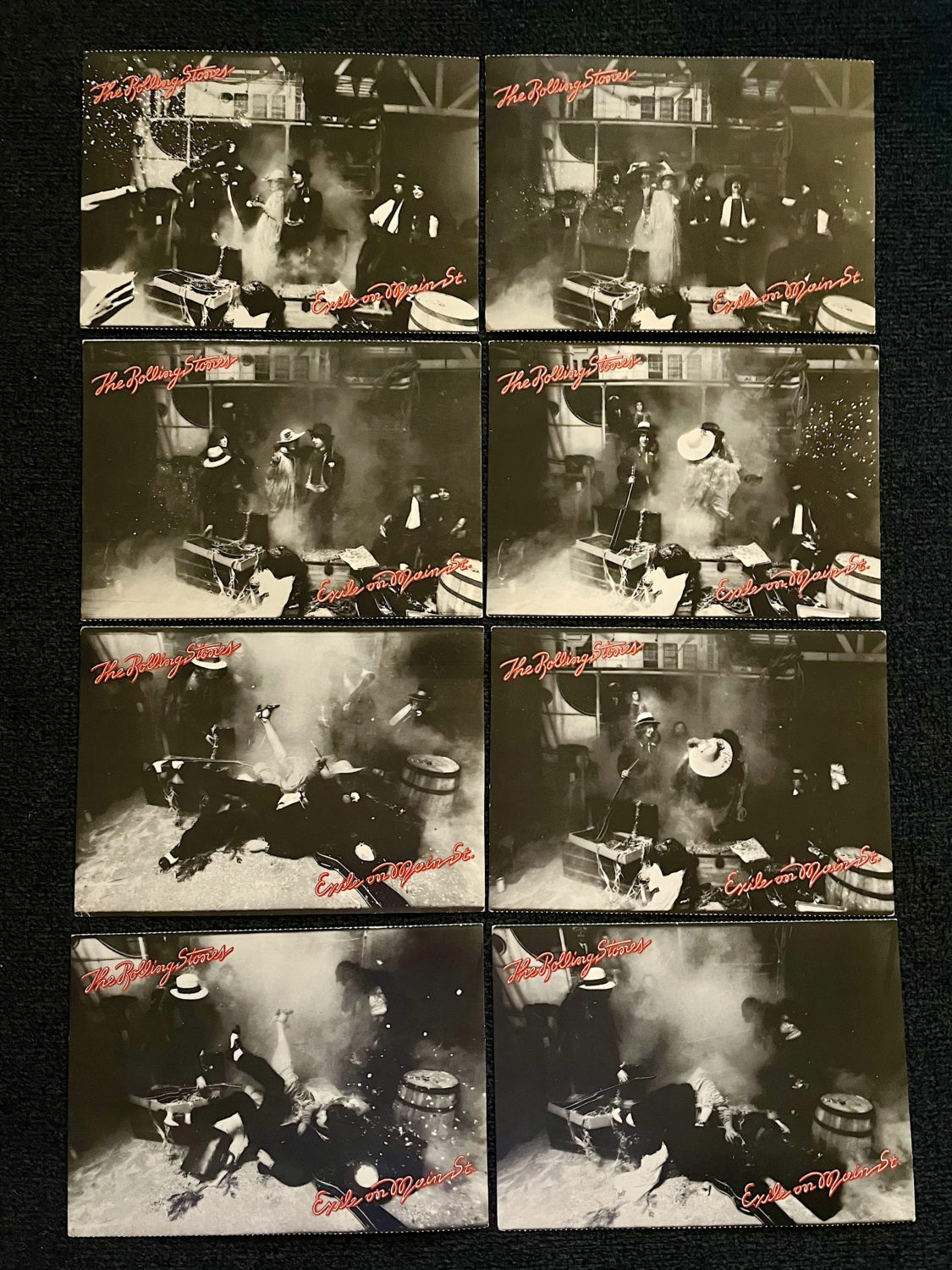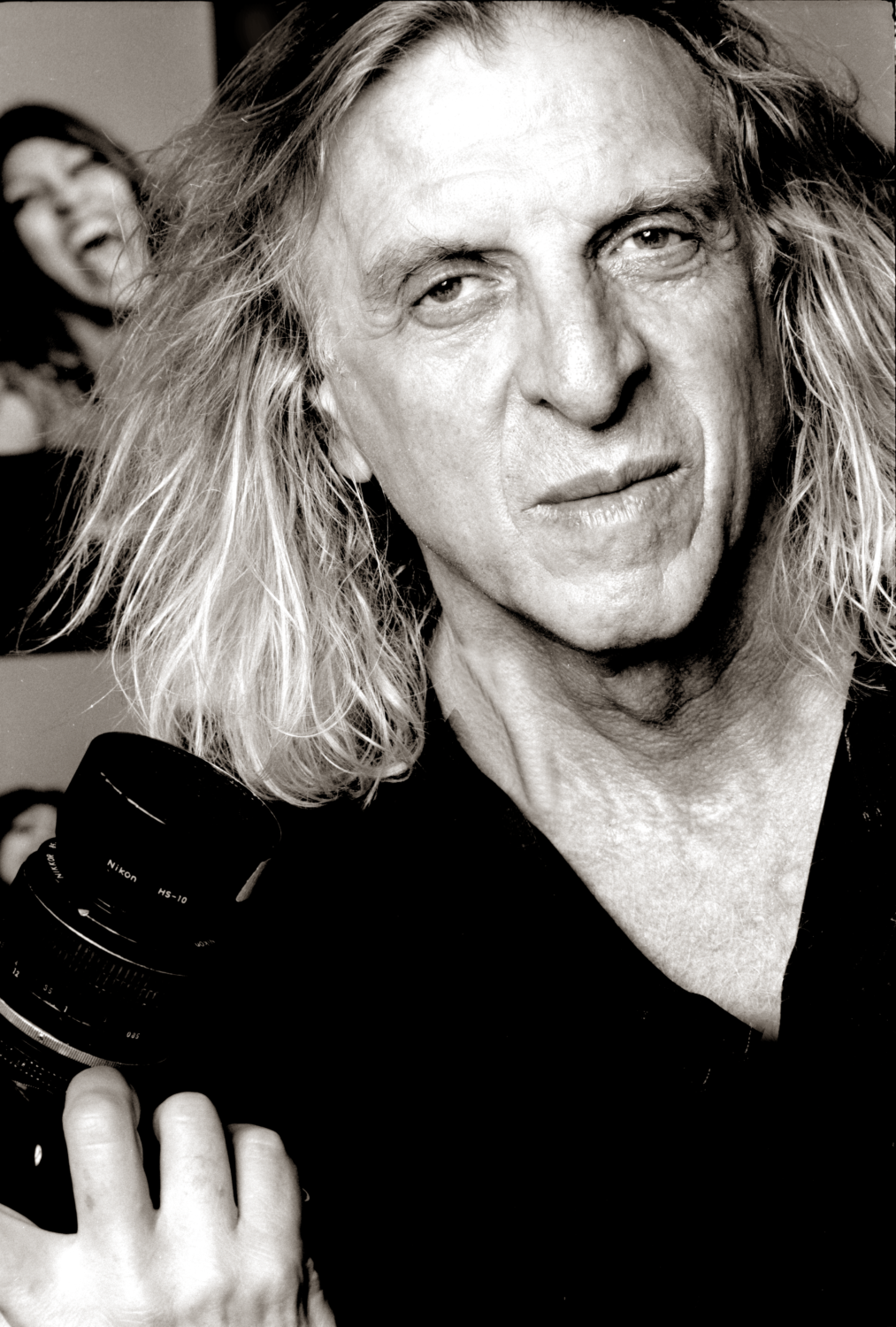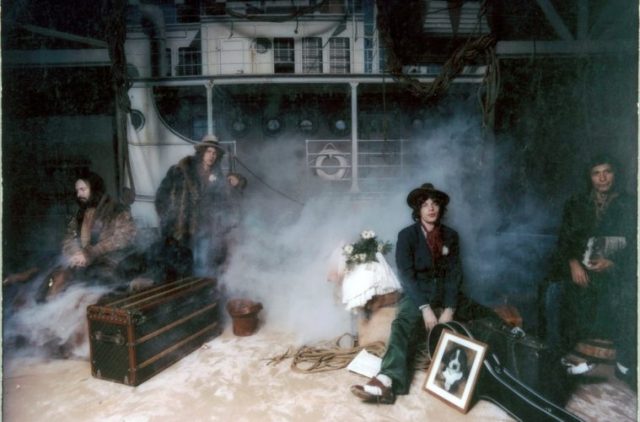Exile on Main Street celebrates its 50th anniversary this month. It is widely regarded as the Rolling Stones’ most important album, but even if it isn’t your favorite, if you’re a Stones fan, you know it’s special, especially as representation of the time when Mick, Keith and the boys were at their coolest and most creative. Coming off the sexy Americana-tinged grit of Sticky Fingers, Exile saw the band at a melodic high point in songwriting and stylistic output, evoking hedonism, wistfulness and defiance as they had “exiled” themselves to avoid exorbitant UK taxes. The year was 1972, and music in general had an effortless excess about it. (The Black Crowes just released an EP celebrating songs from the year, and it opens with Exile’s first track “Rocks Off”). Photographer Norman Seeff was privy to much of the creative planning for the iconic record, as he worked with Mick Jagger and John Van Hamersveld on art direction and photography.
Through Sunday, June 12, Seeff is sharing rare images and ephemera from the project with “50 Years In ‘Exile,’ exhibiting images from his 1972 photo session with the Stones. Vintage photos and the paste-up layout used to produce a set of postcards included with the original pressing of the album will be on display at the exhibit’s Glendale, CA residency. Seeff shared some memories and background on the project and the band with Marina Times.
MARINA TIMES: How did you come to work with The Stones?
NORMAN SEEFF: Well, it’s kind of a very broad story and I’m going to just add some history in there. I was a medical doctor working in emergency medicine in South Africa in Soweto. I had to get out of the country because I didn’t like the South African apartheid system and they didn’t like me. I ended up in New York with one little camera in my hands and, never having been trained in the arts, but in the hubris of youth, thought “I can do anything I want.” I started walking the streets of New York and bumping into interesting people, asking them if I could photograph them. I’d bumped into people like Patti Smith or people from The Factory and I built up this portfolio in New York of what you could call “the subculture.” Suddenly, to my surprise, I ended up as this rock photographer in New York! I didn’t even know when I came from South Africa, that there was a business called the music business where you can take photographs for album covers. I met a man in New York–he was considered the top graphic designer in the music world. He became my mentor and opened up all the doors for me.
After about three years in New York, he recommended that I come to Los Angeles because they were looking for an art director for United Artists Records. Suddenly, you know, from a few years earlier, just walking the streets with a camera, I’m now a head of United Artists, the graphic side. Somehow, my reputation must have reached London. I get a call from someone about The Rolling Stones. They’ll be in L.A. and would I do the shoots. The two biggest projects you could get were shooting either Beatles or The Rolling Stones. I would have been happy with the Beatles as well, but the point is, once you shoot one, you can’t shoot the other. It’s like doing a commercial for Coca Cola. They won’t let you do one for Pepsi.
What was the conceptual idea behind the postcard imagery?
Mick Jagger was pissed off about the tax situation in England and they decided that they needed to leave and go and work in another country. Mick had seen a picture of the Ballet Russes, which was the Russian National Ballet Company. They were traveling the world and what happened is the whole ballet company defected to the States. He’d seen a photograph of them, I think, coming down the ramp of an airplane. The story that I was told was Mick wanted to do it coming down the ramp of a boat, and more kind of period looking–Titanic days, that kind of look. We checked out the Long Beach docks and realized that if we brought the band to Long Beach, we would have 1000 people on the docks and that wasn’t going to work. Then the idea was can we build a set? I found one of the big stages in Hollywood and we had to work quickly. I got my crew and we took one day, starting early in the morning to build the set.
The other part of it was we were told that the Rolling Stones wanted to shoot at midnight so we had from seven in the morning till midnight. I remember buying gallons of cheap red wine, and everyone was drinking all day as we were building the set. We were a little loaded by the end of the day, but when the Rolling Stones arrived, I realized that Mick was more stoned than anybody else in my crew. I was fine with that. The thing—if you do a Rolling Stones project, you had to create what I would call a “Rolling Stones moment.” You can’t just create something that anyone else has done.

Were there any standout memories from the photo session with the band?
The whole period of that time was music was the cultural engine of change at that point. We were breaking free, in everything–sexual revolution, drug revolution, political music became the onus of the movement as well. We were creating cultural icons… I knew that if I photographed The Rolling Stones dressed in a certain way, and that became the billboards, what we produced would become a cultural kind of influencer. At that point, they didn’t have that word, but that’s exactly what album covers were. At the same time, you can’t just do a photo session. Something unusual is going to happen, but I’m not a conceptual person. I’m an experiential photographer. Also I’m not a documentary photographer. I never went to concerts and just photographed artists performing. The artists came to my studio and we developed an interactive communication and a relationship. Without knowing anything, no preconceived, conceptual idea, we allowed the moments to evolve into something that was so powerful emotionally, that basically I would document the experience. It was my kind of approach.
For the Exile session… we started at midnight. We had gone to Western Costume, which was the big movie costume place and we’d gotten all this period clothing. I had to have a whole cast of people so I brought a bunch of the people from my studio and a bunch of girls that worked for my studio assistants and producers and people like that. They all loved it because they’re all dressed up to the nines. Basically, what we had was this boat side set that we built. Stones and the “cast” were supposed to have just disembarked from the ramp. The Rolling Stones are real pros, especially how Mick works—he was drinking wine, but he didn’t look loaded or anything. Keith is another thing–Keith just parties. Basically, it was the Rolling Stones. About two in the morning, we’re getting beautiful shots but that’s all I’m getting. They were standing around and it was all very spontaneous, whatever happens…happens.
In those days, I was shooting Nikon film cameras before digital and there was such a thing as a motor drive, but it wasn’t out really. For each shot that you took, you had to cock the lever and shoot it. Every time I wanted to cock it, I had to do it twice to shoot. I like to shoot very fast, one frame a second because I shoot almost cinematically, but I’m not thinking about the photograph when I’m working with an artist. I’m actually talking to them and engaging them in a relationship with the cameras that had been handed to me by my assistants. Suddenly, my main girl decided she wanted to kiss Mick deeply on the mouth. She spun around and she tried to kiss him. The two of them lost their footing and they literally did a somersault together. I happen to be near them right at the time she kissed him. I got the shot of him flying through the air with his legs up in the air and her legs shot up in the air! Somehow, I was able to cock my camera and shoot it as if it was a movie camera, and I got this incredible sequence of stuff. Next thing is they’re laying on the ground! I’m happy I got my shot. That was what you would call a Rolling Stones moment.
As an art director, designer of album covers as well as a photographer, I was going to design the whole campaign, but I also brought on one of the top graphic people in the world of graphic design. His name was John Van Hamersveld. I did lots and lots of covers with him. You should check him out because his work is brilliant. He’s a genuinely impactful, fine artist. He and I collaborated in doing the whole package which was to become a very famous piece of artwork.
How did the idea to create postcards and include inside of the Exile come about?
John and I looked at what we wanted to do and we both came to the same conclusion that whatever we do, it needs to be something that’s dynamic. Then I remembered, at the time, those days of the Titanic when people went overseas, they would buy these concertina postcards. At this point, the Rolling Stones were living in Bel Air and the idea was that they were going to do a second shoot, it was in Delhi, and I went to the house. And what I said to John, “why don’t we not use the image for the cover? If we make this to look like that particular period and make it one of those concertina things and put it inside the album, we can design the album any way we want.” He came up with some brilliant graphic designs.
We show Mick and he loves the idea of making the postcards. We also said, “Listen, what’s your handwriting like?” So we all sat around the dining room table and we had Mick scribble all the credit lines. John and I and Mick were like a bunch of kids at a sort of kindergarten arts period with a little scissors and tape. We just cut everything up that Mick would write. He would say, “oh, yeah” and write down photography by Norman Seeff. We cut it up and all of us actually just taped up everything onto the album cover. It was very much a kind of a collaborative thing but it was the idea of John’s to do it like that. We published the postcards and we put them in. When people bought the album, they found the postcards and every postcard was different. It was the hip thing to do to write people on your Rolling Stones postcard. Of course, Atlantic Records were incredibly excited. It was like, a whole new way to “pre social media.” That’s the story around the evolution of an album cover, which becomes very much integrated into society. Then we also designed the campaigns for billboards. It was very strong. It won a bunch of awards. It was a collaborative process of Norman, John and Mick to actually create this piece. So that was the evolution of the whole process.
What about the cover?
John had found these amazing pictures of this guy with big balls in his mouth and there was also a wonderful documentary filmmaker, who was shooting the Rolling Stones on 16 millimeter film. We took his film, we made copies, we cut it up, and we did a collage with the circus performers, that kind of stuff. It was just a crazy, irrational, meaningless cover. My photography was meant to be the cover was now it moved to the inside. Unfortunately, what happened is the record company, to save money later on after the first release, stopped putting the postcards in. Subsequently,, the postcards have become collector’s editions in it, with people trying to find them.

So how did this iconic session inspire or affect your photography career?
I’m new in the world. I’m still very fresh. I don’t even think of myself yet as successful. It takes a while as an artist. You’re always in a state of what I call “divine discontent” because it’s exciting, the creative process, but you never think it’s good enough. For me the impact of suddenly, after giving up a career in medicine, I’m the guy that Mick Jagger decides should shoot his next album? It started dawning on me ‘maybe you’re going to be okay. Maybe you’re going make it, you know?’ I was like, “Oh, okay, so getting the Rolling Stones in my portfolio of people I’ve shot gives me a certain credibility.” My art form is an art form of basically creative communication. I’m literally exploring the creative process with the artist, but creating this intimate interaction with them, and in a duality of being compassionately concerned about them feeling safe. At the same time, saying, if you don’t push your boundaries, all you get is mediocrity.
What I started doing was when I had artists performing, if they did a song, I’d make them do a song over and over and over again and push them to do it different ways. Often artists would get ideas and what would happen in the photo session would be things that they would integrate later on onstage. We would also explore stuff. I would spray them with water and mess up their hair, really take away the comfort zone that artists would come in and think, “Oh, I’m coming in, you’re photographing me,” and I’m saying, “I’m not photographing you, you are going to be seen, the images that come out from today, first of all, will create a permanent, iconic identity for you on a global scale. Millions and millions of people will see these images.” I mean, the Rolling Stones, those images must have been published 10-20 million times.
A lot of my work was about once I’ve created the safety, and they knew my motivation, that I’m not there to try and manipulate or control them. They have to feel I was as much on the frontline as they are. So that whole process was what I was learning. What I learned out of that session and others is that even though you’re working with the most iconic artists, you cannot project onto them.
And what are you working on now?
I’ve been filming my sessions for years, I’ve got the largest unseen archive of film sessions of artists in the act of creation. We are now building a TV series and a feature film. I’m a multimedia artist who used film and photography as my vehicle to do what I really do, which is explore the inner journey of the creative process that artists go through in order to create. Realize that the great artists are what you’d call boundary-pushing artists. They live on the threshold of the unknown and they are willing to go into that place where I wanted them to go. The great artists are adventurers, and every session is an encounter with an artist willing to break their own threshold. What I’m saying is that everyone has access to the same resources of creativity, but most of us are too scared to use it. The great artists are scared but they go anyway. It’s an incredibly courageous heroic journey. That’s what my project’s going be—it’s going to be called Norman Seeff: The Power and Passion To Create Encounters With the Artists. That’s the real work right now, but the idea is to bring this material out to show people that we’re all creative. We all have the same emotional powers and strengths. we just have to be courageous enough to go on the journey. Creativity is a hero’s journey.
(This interview has been edited for length and clarity)
“50 Years in Exile” at the Rock Photography Museum Special Exhibition Space, 123 Artsakh, Glendale; opens Sat., May 14 and runs through Sun., June 12. More info at Rockphotographymuseum.com and Seeffvintagephotos.com.





